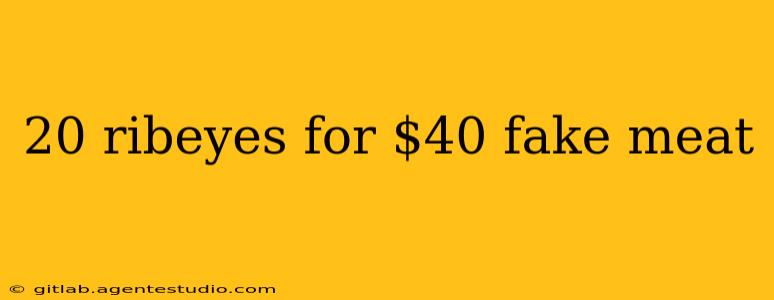The headline grabs you, doesn't it? Twenty ribeyes for forty dollars? Sounds too good to be true, and in the realm of real ribeyes, it almost certainly is. But the rise of plant-based meat alternatives has opened up a fascinating new market, one where impressive price points are increasingly common. Let's delve into the world of affordable fake meat and explore what's behind those tantalizingly low prices.
The Appeal of Cheap "Ribeyes"
The promise of a budget-friendly, meat-like experience is incredibly attractive. Many consumers are seeking alternatives to traditional beef for ethical, environmental, or health reasons. A significantly lower price point makes plant-based options even more appealing, especially for those on a tight budget or looking to incorporate more meat alternatives into their diet without breaking the bank. The psychological impact of seeing "20 ribeyes for $40" is powerful, tapping into desires for value and abundance.
Understanding the Economics of Fake Meat
Several factors contribute to the potentially lower price points of plant-based meat compared to its animal-based counterpart:
Lower Production Costs:
- Raw Materials: The primary ingredients in many plant-based meats are often less expensive than raising and processing livestock. Think soy, peas, wheat, etc. The cost of feed, land, and animal care is eliminated.
- Processing: While the processing of plant-based meat still requires machinery and energy, the scale and complexity are often less than traditional meat processing.
- Distribution: Depending on the manufacturer and distribution network, transportation costs may be lower or more efficient.
Economies of Scale:
As the plant-based meat industry grows, economies of scale are driving down production costs. Larger production runs and optimized manufacturing processes lead to lower per-unit costs.
Marketing & Branding:
While some brands focus on premium pricing and highlight high-quality ingredients, others target a budget-conscious market, accepting lower profit margins to gain market share and build brand recognition. This competitive landscape helps keep prices low.
The "Catch" – What You Should Consider
While the price is undeniably attractive, it's crucial to be aware of a few potential caveats:
- Ingredient Quality: Budget-friendly options might use less expensive, and potentially less desirable, ingredients. Always check the label.
- Nutritional Value: The nutritional profile can vary widely. Some plant-based meats are fortified with vitamins and minerals, while others may lack certain nutrients found in real meat.
- Taste and Texture: The taste and texture of budget-friendly alternatives might not perfectly replicate the experience of a real ribeye. Consumer reviews are a good place to check this.
- Sustainability: While often marketed as a sustainable alternative, the environmental impact of plant-based meat production varies depending on the ingredients and manufacturing processes. Look for brands committed to sustainable practices.
Finding Your Perfect Balance
The availability of affordable plant-based meat offers a great opportunity for consumers to experiment with different dietary options. But remember that the "20 ribeyes for $40" headline is a marketing tactic designed to attract attention. Focus on comparing brands, reading labels, and considering your individual needs and preferences to find the best option for you—whether it's a budget-friendly plant-based option or a higher-quality, but potentially more expensive, alternative. Ultimately, smart shopping and informed choices are key to navigating this exciting and rapidly evolving market.

